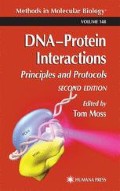Abstract
Interactions of proteins with nucleic acids play important roles in biological phenomenon. Almost every stage in the regulation of gene expression involves the interaction of proteins with specific nucleic acids sequences. The identification of the nucleic acid recognition sequence of a given DNA-binding protein is therefore often the first step to be undertaken in the study of its biological function. Over the last 10 yr, the SELEX procedure (systematic evolution of ligands by exponential enrichment) has been used to identify high-affinity nucleic acids ligands for a large number of different proteins. The method was first described for the identification of the DNA and RNA target sequences of nucleic-acid-binding proteins (1,2) but has since been used for the selection of the nucleic acid sequence ligands for other kinds of molecules (3). SELEX uses the power of genetic selection while taking advantage of in vitro biochemistry. It is a rapid technique that is relatively easy to implement and can accelerate and simplify nucleic-acid/protein interaction studies.
Access this chapter
Tax calculation will be finalised at checkout
Purchases are for personal use only
References
Oliphant, A. R., Brandl, C. J., and Struhl, K. (1989) Defining the sequence specificity of DNA-binding proteins by selecting binding sites from random-sequence oligonucleotides: analysis of yeast GCN4 protein. Mol. Cell. Biol. 9, 2944–2949.
Tuerk, C. and Gold, L. (1990) Systematic evolution of ligands by exponential enrichment: RNA ligands to bacteriophage T4 DNA polymerase. Science 249, 505–510.
Gold, L., Polisky, B., Uhlenbeck, O., and Yarus, M. (1995) Diversity of oligo-nucleotide functions. Annu. Rev. Biochem. 64, 763–797.
Ellington, A. D. and Szostak, J. W. (1990) In vitro selection of RNA molecules that bind specific ligands. Nature 346, 818–822.
Irvine, D., Tuerk, C., and Gold, L. (1991) SELEXION. Systematic evolution of ligands by exponential enrichment with integrated optimization by nonlinear analysis. J. Mol. Biol. 222, 739–761.
Bouvet, P., Matsumoto, K., and Wolffe, A. P. (1995) Sequence-specific RNA recognition by the Xenopus Y-box proteins. An essential role for the cold shock domain. J. Biol. Chem. 270, 28,297–28,303.
Ghisolfi-Nieto, L., Joseph, G., Puvion-Dutilleul, F., Amalric, F., and Bouvet, P. (1996) Nucleolin is a sequence-specific RNA-binding protein: characterization of targets on pre-ribosomal RNA. J. Mol. Biol. 260, 34–53.
Triqueneaux, G., Velten, M., Franzon, P., Dautry, F., and Jacquemin-Sablon, H. (1999) RNA binding specificity of Unr, a protein with five cold shock domains. Nucleic Acids Res. 27, 1926–1934.
Tsai, D. E., Harper, D. S., and Keene, J. D. (1991) U1-snRNP-A protein selects a ten nucleotide consensus sequence from a degenerate RNA pool presented in various structural contexts. Nucleic Acids Res. 19, 4931–4936.
Bartel, D. P., Zapp, M. L., Green, M. R., and Szostak, J. W. (1991) HIV-1 Rev regulation involves recognition of non-Watson-Crick base pairs in viral RNA. Cell 67, 529–536.
Gao, F. B., Carson, C. C., Levine, T., and Keene, J. D. (1994) Selection of a subset of mRNAs from combinatorial 3 untranslated region libraries using neu-ronal RNA-binding protein Hel-N1. Proc. Natl. Acad. Sci. USA 91, 11,207–11,211.
Singer, B. S., Shtatland, T., Brown, D., and Gold, L. (1997) Libraries for genomic SELEX. Nucleic Acids Res. 25, 781–786.
Pollock, R. and Treisman, R. (1990) A sensitive method for the determination of protein-DNA binding specificities. Nucleic Acids Res. 18, 6197–6204.
Ringquist, S., Jones, T., Snyder, E. E., Gibson, T., Boni, I., and Gold, L. (1995) High-affinity RNA ligands to Escherichia coli ribosomes and ribosomal protein S1: comparison of natural and unnatural binding sites. Biochemistry 34, 3640–3648.
Tuerk, C., Eddy, S., Parma, D., and Gold, L. (1990) Autogenous translational operator recognized by bacteriophage T4 DNA polymerase. J Mol Biol 213 749–761.
Author information
Authors and Affiliations
Editor information
Editors and Affiliations
Rights and permissions
Copyright information
© 2001 Humana Press Inc., Totowa, NJ
About this protocol
Cite this protocol
Bouvet, P. (2001). Determination of Nucleic Acid Recognition Sequences by SELEX. In: Moss, T. (eds) DNA-Protein Interactions. Methods in Molecular Biology, vol 148. Humana Press. https://doi.org/10.1385/1-59259-208-2:603
Download citation
DOI: https://doi.org/10.1385/1-59259-208-2:603
Publisher Name: Humana Press
Print ISBN: 978-0-89603-625-3
Online ISBN: 978-1-59259-208-1
eBook Packages: Springer Protocols

